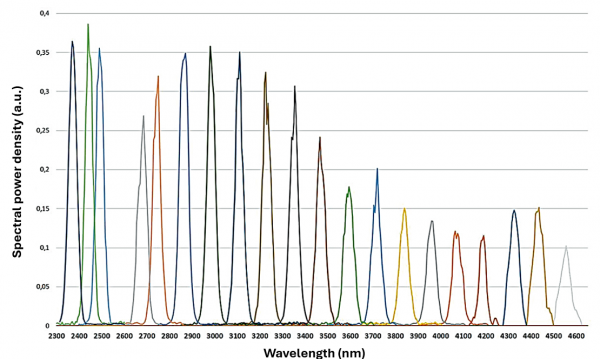
Supercontinuum Laser vs. OPO: Understanding the Differences
In the world of ultra-wideband tunable laser technology, there are two prominent options that stand out: the supercontinuum laser and the optical parametric oscillator (OPO). Both broadband laser technologies offer unique capabilities for generating tunable coherent light across a broad spectrum, but their underlying principles and technical distinctions set them apart. This blog post explores the technical details of each laser type, shedding light on their differences and applications.
Supercontinuum Lasers
A supercontinuum laser is a type of broadband laser also known as a white light laser. It is a remarkable device that generates an ultra-broadband spectrum of coherent light. For example, Leukos supercontinuum lasers can provide wavelengths starting at 350nm, with options reaching well into the mid-infrared. The broad spectrum generated by these broadband lasers arises from a complex interplay of nonlinear optical effects within a specialized optical fiber.
Operating Principle
The supercontinuum generation process begins with a high-intensity single-wavelength laser pulse, typically from a femtosecond or picosecond laser, being injected into a highly nonlinear optical fiber that results in a broadband laser output. As the pulse propagates through the fiber, various nonlinear phenomena, such as self-phase modulation, stimulated Raman scattering, and four-wave mixing, come into play. These effects interact with the pulse, causing its spectrum to broaden dramatically, often spanning hundreds of nanometers or more.
Key Characteristics
- Ultra-Broadband Spectrum: Supercontinuum lasers generate a continuous spectrum of light, encompassing a wide range of wavelengths, from the ultraviolet to the infrared.
- High Spatial and Temporal Coherence: The emitted light maintains a high degree of spatial and temporal coherence, making it suitable for applications requiring precise control of light waves.
- Compact and Fiber-Based: Supercontinuum lasers can be built in compact and fiber-based configurations, offering flexibility and ease of integration into various systems.
- Tunable Output: Supercontinuum are routinely coupled with tunable filters resulting in a broadband tunable source.

Output of a LEUKOS ELECTRO MIR 4.8 supercontinuum laser combined with a SALSA tunable filter offering a tuning range of 2300nm.
Optical Parametric Oscillator (OPO)
An optical parametric oscillator (OPO) is a versatile broadband laser source that leverages nonlinear optical interactions to generate coherent light at tunable wavelengths. It operates based on the principle of parametric down-conversion, where a high-energy single-wavelength pump photon is converted into two lower-energy photons, known as the signal and idler. For example, Chromacity’s Auskerry OPO, when pumped at 1040 nm, can generate an output tunable between 1.4µm and 4.2 µm.
Operating Principle
The OPO laser typically consists of a nonlinear crystal placed within an optical cavity. A high-intensity fixed frequency pump laser is directed into the crystal, where parametric down-conversion occurs. A high-frequency beam is split at the nonlinear crystal into two low-frequencies. The generated signal and idler photons resonate within the cavity, leading to amplification and the emission of coherent light at the desired wavelengths.
Key Characteristics
- Tunable Output: OPO lasers offer the ability to tune the output wavelength across a broad spectral range by adjusting the crystal properties or the cavity parameters.
- High Output Power: OPO lasers can generate high output powers, making them suitable for applications requiring intense light sources.
- Wavelength Range: OPO lasers are often used to generate tunable light in the near-infrared (NIR) and mid-infrared (MIR).

Output of a Chromacity Auskerry OPO showing two ranges: signal at 1.4µm – 1.8µm and idler at 2.4µm – 4.2µm.
Technical Differences
| Feature | Supercontinuum Laser | Optical Parametric Oscillator (OPO) |
|---|---|---|
| Spectral Broadening Mechanism | Nonlinear effects in optical fiber | Parametric down-conversion in nonlinear crystal |
| Spectral Output | Ultra-broadband continuous spectrum possible from UV to mid-IR | Narrowband, but tunable within specific ranges (signal and idler) |
| Wavelength Tuning | Not directly tunable; tunability requires spectral filter accessories | Directly tunable by adjusting the phase-matching conditions or cavity parameters |
| Output Power | Typically lower than OPOs | Can achieve high output powers |
| Linewidth | Narrow linewidth when using optical filters | Can achieve narrow linewidths |
| Pulse Duration | Typically nanosecond or picosecond pulses | Can generate nanosecond to femtosecond pulses |
| Spatial Coherence | High spatial coherence | High spatial coherence |
Applications
Both supercontinuum lasers and OPOs, as tunable broadband laser sources, find applications in a wide range of fields, including:
- Spectroscopy: Their broad spectral coverage and high coherence make them valuable tools for spectroscopic analysis, for example for stand-off detection and multi-species gas analysis.
- Biomedical Imaging: Their ability to generate light at specific wavelengths enables various biomedical imaging techniques, such as multiphoton microscopy and optical coherence tomography.
- Materials Processing and Characterization: High output powers can be used for materials processing applications, such as laser ablation and micromachining. Interrogation of photonics integrated circuits.
- Telecommunications: Their tunable wavelengths and high output powers are utilized in telecommunications systems for data transmission and signal amplification.
Conclusion
Supercontinuum lasers and optical parametric oscillators represent two distinct approaches to generating coherent light in a wide wavelength range with unique characteristics and capabilities. While both offer broadband spectral coverage, their underlying principles, spectral output, tuning mechanisms, and output powers differ significantly. Understanding these technical differences is crucial for selecting the appropriate laser source for specific applications. As technology advances, both supercontinuum lasers and OPOs are expected to continue playing a vital role in shaping the future of photonics and laser-based applications. Contact Axiom Optics for more information and to help you choose the right product for your application.
